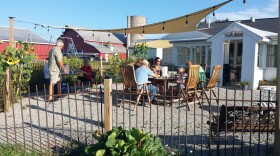County Fairs and harness racing go hand in hand. The 200 year old sport has been dominated by men, but here in Ohio, a group of women are changing that.
At the Darke County Fairgrounds in Greenville, a group of eight women harness racers are circling the dirt track in front of a crowded grandstand. They sit on two wheeled sulkies pulled by sleek race horses, waiting for the start of the sixth race. Over the speaker comes the announcement for the Annie Oakley Shoot-Out. The horses and drivers start pacing down the track behind the white truck with the starting gate attached, they get up to racing speed, the gate opens, and off they go.
Nine years ago on this same track, women harness drivers got their own race for the very first time in Ohio. Emily Hay, who's racing today, was one of five women in that race. She talked about it as she was tacking up her horse in the race barn.
“Yep, there was five, Emily says. "And it was really hard to find people to drive and get girls that had their fair license. Just not that many were into and they always just thought of it [as] a guy's sport and we’ll let the guys do it, and not a lot of interest.”
I

n 2011, the glory days of harness racing in Ohio were waning. The state had dropped from number one to number four in breeding the trotters and pacers known as Standardbreds. The industry was also hurting financially with low attendance at races. Tim Harless, the harness racing organizer for the Darke County Fair, contacted Emily about having a ladies-only race, hoping to encourage more spectators. Emily took that and ran with it, turning that race into an annual series on the Ohio county fair circuit.
“The first couple of years we struggled to get horses and drivers because there just weren’t that many,” Emily says. “But then after a couple years, younger girls, older girls, they decided hey that looks like fun, so they started joining in. And now this year I think we had every race filled, and we probably have 21 different girl drivers. And I know out of that, there’s probably 6 to 8 that have went on and got their 'P license' from just doing this series.”
Most of the women that race at the fairs are amateur drivers, which means they don’t get paid. A "P license" allows drivers to race for money at parimutuel tracks like the Dayton Raceway at the downtown casino. One of tonight’s racers, Jazmin Arnold, was going to her very first parimutuel race at Scioto Downs a few days after this race.
"I’m excited and nervous all at the same time,” Jazmin says. “It’s a lot different. Those boys do that for a living, so it’s kinda tough.”
Jazmin is the fourth generation of harness racers in her family. She trained her first horse to the race bike at 8 years old. “So I was tiny,” she says laughing.
Jazmin is racing tonight against her best friend Alesha Binkley. The two grew up together. Alesha just started driving last year, but she’s been around it all her life.
“I wasn’t really interested in it for a long time,” Alesha says. "I played a lot of sports. About my senior year I started coming around to the horses again. The adrenaline rush, it’s amazing.”
“I played sports my whole life and with injuries I can no longer compete, so this is my way of competing,” says Mandy Jones, another driver here tonight. “ My first win was with a colt named Northern Companion. We bought him as a baby, broke him, and I won with him at my first race. It was really cool, and then we sold him and he went down to Florida and he ended up being the best open pacer down there for a few years.”
“My dad made me read the care and training of a trotter and pacer,” chimes in driver Elizabeth Murphy, “I had to read that book and clean stalls before I was allowed to even jog a horse. I actually won my very first start against the guys at Washington Court House Fair.”
One of the male drivers who’s watching the women race says, “When I first started there were maybe two women drivers. So it’s good to see women that actually are as good as possibly some of the men, and trainers that actually don’t have a problem putting women down [on the race card] because they can do just as good with a horse as a man can. I think it’s good for the sport for both men and women to get out there and compete.”
The race ends with Jazmin winning on Mr. Coolie. Back in the barns little girls are helping cool down the horses. Judging by all the little girls in the barn, it looks like the ranks of women drivers will only continue to grow. One nine year old holding a water bucket up to a sweaty race horse smiles and says she can see herself doing this.
Emily says the women racers are good role models for the sport. “Well all the girls get along really good. So that helps too.” Emily says as she leads her horse into a stall, “ Like you’re all friends. Even on the race track, we all know that what happens on the race track stays on the track, you leave it on the track. Cause you’re out there to race, everyone’s out there to win.”
County Lines is WYSO's series on rural life, made possible by a grant from Ohio Humanities.




